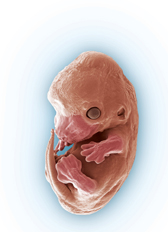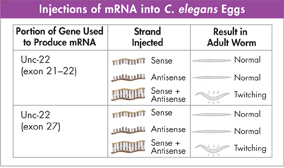Analyzing Data
The Discovery of RNA Interference
In 1998, Andrew Fire and Craig Mello carried out an experiment that helped explain the mechanism of RNA interference. They used RNA from a large gene called unc-22, which codes for a protein found in muscle cells. They prepared short mRNA fragments corresponding to two exon regions of the gene and injected them into egg cells of the worm C. elegans. Some of their results are shown in the table.
Draw Conclusions How did the adult worms' responses differ to injections of single-stranded mRNA (the “sense” strand), its complementary strand (“antisense”), and double-stranded RNA (“sense + antisense”)?
Form a Hypothesis Twitching results from the failure of muscle cells to control their contractions. What does this suggest about the unc-22 protein in some of the worms? How would you test your hypothesis?
Infer The injected fragments came from two different places in the gene and were only a few hundred bases long. The unc-22 mRNA is thousands of bases long. What does this suggest about the mechanism of RNA interference?
The Promise of RNAi Technology The discovery of RNAi has made it possible for researchers to switch genes on and off at will, simply by inserting double-stranded RNA into cells. The Dicer enzyme then cuts this RNA into miRNA, which activates silencing complexes. These complexes block the expression of genes producing mRNA complementary to the miRNA. Naturally this technology is a powerful way to study gene expression in the laboratory. However, RNAi technology also holds the promise of allowing medical scientists to turn off the expression of genes from viruses and cancer cells, and it may provide new ways to treat and perhaps even cure diseases.
Genetic Control of Development
 What controls the development of cells and tissues in multicellular organisms?
What controls the development of cells and tissues in multicellular organisms?
Regulating gene expression is especially important in shaping the way a multicellular organism, like the mouse embryo in Figure 13–19, develops. Each of the specialized cell types found in the adult originates from the same fertilized egg cell. Cells don't just grow and divide during embryonic development. As the embryo develops, different sets of genes are regulated by transcription factors and repressors. Gene regulation helps cells undergo differentiation, becoming specialized in structure and function. The study of genes that control development and differentiation is one of the most exciting areas in biology today.

FIGURE 13–19 Differentiation This scanning electron micrograph shows a mouse embryo undergoing cell differentiation 23 days after conception.
Table of Contents
- Formulas and Equations
- Applying Formulas and Equations
- Mean, Median, and Mode
- Estimation
- Using Measurements in Calculations
- Effects of Measurement Errors
- Accuracy
- Precision
- Comparing Accuracy and Precision
- Significant Figures
- Calculating With Significant Figures
- Scientific Notation
- Calculating With Scientific Notation
- Dimensional Analysis
- Applying Dimensional Analysis





